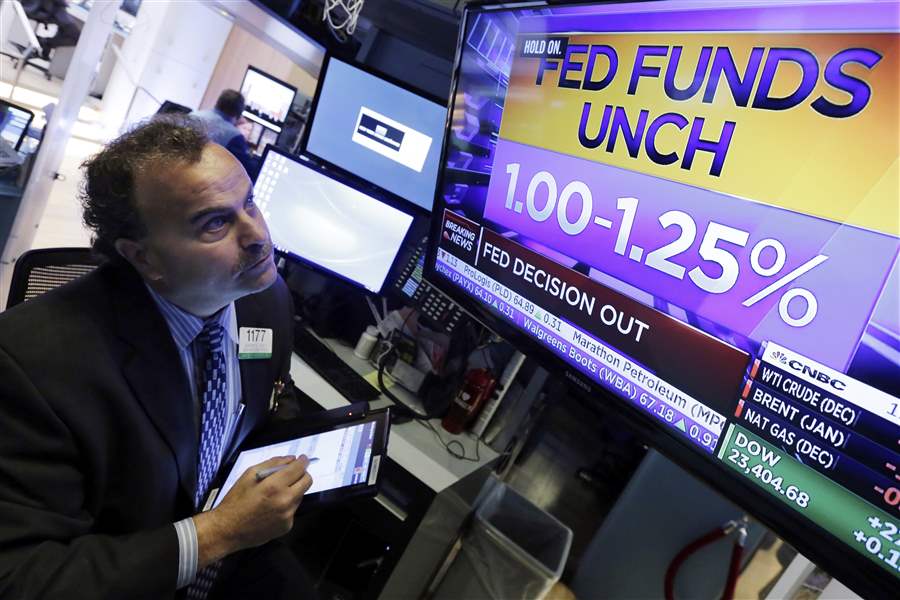
S&P 500 inches closer to record as global stocks rise
11/1/2017
Trader Gerard Farco watches a television on the floor of the New York Stock Exchange showing the rate decision of the Federal Reserve, Wednesday, Nov. 1.
ASSOCIATED PRESS
NEW YORK — Rising energy stocks helped nudge the Standard & Poor’s 500 close to its record high, but drops for smaller stocks left U.S. indexes mixed on Wednesday.
Markets around the world were broadly higher as investors got more evidence that the global economy is strengthening and corporate profits are climbing. The Federal Reserve said the U.S. economy is rising “at a solid rate,” even with damage from recent hurricanes, as it announced a decision to hold interest rates steady at their low levels.
RELATED: Searchable stock index
The S&P 500 rose 4.10 points, or 0.2 percent, to 2,579.36. Earlier in the day, it had climbed above its record closing high of 2,581.07 set last week.
The Dow Jones industrial average gained 57.77 points, or 0.3 percent, to 23,435.01. Other U.S. indexes weakened. The Nasdaq composite fell 11.14 points, or 0.2 percent, to 6,716.53. The small-cap Russell 2000 index lost 10.00 points, or 0.7 percent, to 1,492.78.
Energy stocks led the market, and those in the S&P 500 rose 1.1 percent for the biggest gain among the sectors that make up the index. They climbed after the price of oil topped $55 per barrel to touch its highest level since Jan. 3, though it backtracked as the day went on.
Estee Lauder jumped to the biggest gain in the S&P 500 after strong sales growth in China and Hong Kong helped it to report a bigger profit than analysts expected. It rose $10.31, or 9.2 percent, to $122.12.
The cosmetics giant joined the growing list of companies that beat analysts’ expectations for earnings in the most recent quarter. Nearly two thirds of companies in the S&P 500 have said how they performed from July through September, and the majority have topped Wall Street’s forecasts.
They have been reaping better revenue and profits as the economy strengthens, and a report on Thursday showed that private employers added more jobs last month than economists expected. It raises expectations that Friday’s more comprehensive jobs report from the government will be strong too.
“What we’ve been waiting for the last five-plus years is stronger economic growth leading to better employment numbers, or one feeding into the other, and leading to stronger wage growth,” said Jon Mackay, investment strategist at Schroders. “We just haven’t seen the wage growth part of it, but now we’re seeing the wage growth start to tick through.”
Other economies around the world are also improving in sync, which further raises optimism. “Globally, it tends to have a self-reinforcing effect,” Mackay said. “People buy more goods from the U.S., emerging-market economies do better, banks have the capacity to lend more, and that leads to more capital spending and more consumer spending. At some point, it becomes overdone, but we’re not anywhere close to that yet.”
With the economy improving, the Federal Reserve has been slowly increasing interest rates from their record low. On Thursday, it decided to hold rates steady, but most economists expect it to raise them at its next meeting in December.
The weakest part of the stock market on Thursday was smaller stocks. They have generally been rising and falling in recent weeks with expectations that Congress will be able to overhaul the tax system and cut rates. Smaller companies often pay higher tax rates than their bigger rivals.
But House Republicans missed a self-imposed Wednesday deadline for a public release of their tax plan, as members debate whether to change the tax benefits of 401(k) contributions and other details. The rollout appears set for Thursday.
In overseas stock markets, the French CAC 40 rose 0.2 percent, the FTSE 100 in London dipped 0.1 percent and Germany’s DAX rose 1.8 percent. The Japanese Nikkei 225 index jumped 1.9 percent, South Korea’s Kospi gained 1.3 percent and the Hang Seng in Hong Kong climbed 1.2 percent.
In the commodities market, benchmark U.S. crude dipped 8 cents to settle at $54.30 per barrel. Brent crude, the international standard, fell 45 cents to $60.49. Natural gas was virtually flat at $2.89 per 1,000 cubic feet, heating oil fell 2 cents to $1.86 per gallon and wholesale gasoline rose 1 cent to $1.74 per gallon.
Gold rose $6.80 to settle at $1,277.30 per ounce, silver gained 48 cents to $17.18 per ounce and copper climbed 4 cents to $3.14 per pound.
The 10-year Treasury yield dipped to 2.37 percent from 2.38 percent late Tuesday. The two-year yield held steady at 1.60 percent, and the 30-year yield dipped to 2.85 percent from 2.88 percent.
The dollar rose to 114.22 Japanese yen from 113.71 yen late Tuesday. The euro dipped to $1.1620 from $1.1651, and the British pound fell to $1.3249 from $1.3282.